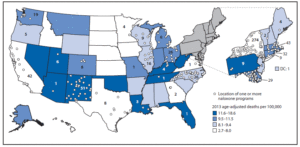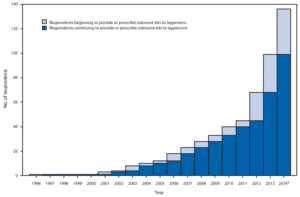If you’d rather not leave a comment or just don’t have the time please click the like button at the bottom of the page.
American Heroin
August 3rd, 2016
You probably have met someone who has used heroin or other opioid. With the way things are going it’s probable that you’ll meet someone who will die from opioid overdose. This epidemic is claiming 78 lives a day. Folks are starting to take a look at this addiction as stronger than the average willpower. It was thought that “just degenerates and undesirables get strung out on that junk” but it’s showing up in the homes of suburban middle class America. Gloucester Mass. Police Chief Leonardo Campanello says “we lost the war on drugs”; at least by the way we were waging it. Heroin is significantly cheaper than it was when the war on drugs started in 1971 and 3 to 5 times as many people are engaging in illegal drug activity. So Campanello started treating it as a public health issue. That is instead of putting people in jail for drug abuse the police department gets them into treatment and other police stations are following suit. We have to get rid of the idea that people who use drugs are scum. Addicts should be thought of as a normal person with a pretty severe problem but a problem that they can overcome. Help from others goes much further toward a solution than hate from others. There’s a person lost in the, “I’ll do anything for a fix,” alien that’s before you. If you knew one of the 78 dead today you’d miss that person.
 Naloxone will reverse an overdose if administered soon enough after the event. It’s brand name Narcan, I believe these are hydrochlorides. You do not have to be a professional to obtain or use the substance. You may be able to find a kit and training in your state. To the left is a map of where programs are setup in the United States. Click the map to enlarge.
Naloxone will reverse an overdose if administered soon enough after the event. It’s brand name Narcan, I believe these are hydrochlorides. You do not have to be a professional to obtain or use the substance. You may be able to find a kit and training in your state. To the left is a map of where programs are setup in the United States. Click the map to enlarge.
The (HRC) Harm Reduction Coalition conducted a survey of 140 organizations to get an idea of how effective naloxone kits were. 136 of them completed the survey that ran from January 2013 to June 2014. In 2013 43,982 people overdosed. 16,235 (37%) were opioid prescription overdoses. 8,257 (19%) were heroin overdoses. 152,283 kits were supplied to (81.6%) of other drug users, (11.7%) to family members, (3.3%) to service providers and (3.4%) unknown. There were 26,463 overdose reversals; people who get a second, third, forth, or how ever many chances it takes to get clean. Why should folks be provided with that many chances to live? Because of how powerful heroin and opioid addiction are. Until we raise children that are better equipped and prepared to coexist with such powerful substances we should stay the course. It’s going to help someone that you know directly or indirectly at some point. Also at (81.6%) is the amount of heroin overdoses where a naloxone kit was used. More has to be done to get naloxone into the hands of prescription opioid abusers who had twice as many overdoses as heroin. With the popularity that naloxone has found comes increased prices. Yes, it will cost a little more to be brought back from death’s door than it used to. This could hurt the effectiveness of any overdose treatment structure.
 Opponents of naloxone distribution say it’s given addicts the green light to do as much heroin as they want; that naloxone allows addicts to have riskier behavior. One doctor compared it to seat belts in a car causing more reckless driving. Not only that; naloxone takes your buzz away and plunges you into instant withdrawal. I don’t think that’s attuned to the addictive personality. The “it’s not my problem” approach to this problem isn’t working. As more and more families are effected by addiction people are seeing that the criminalization of drug abuse fills prisons takes massive resources and doesn’t produce less offenses. It actually produces more. It creates a stigma of worthlessness that is still with us today. States have passed legislation to make naloxone easier to obtain with the exception of Kansas, Montana, and Wyoming. Above is a chart of survey respondents starting to and continuing to prescribe naloxone kits to laypersons.
Opponents of naloxone distribution say it’s given addicts the green light to do as much heroin as they want; that naloxone allows addicts to have riskier behavior. One doctor compared it to seat belts in a car causing more reckless driving. Not only that; naloxone takes your buzz away and plunges you into instant withdrawal. I don’t think that’s attuned to the addictive personality. The “it’s not my problem” approach to this problem isn’t working. As more and more families are effected by addiction people are seeing that the criminalization of drug abuse fills prisons takes massive resources and doesn’t produce less offenses. It actually produces more. It creates a stigma of worthlessness that is still with us today. States have passed legislation to make naloxone easier to obtain with the exception of Kansas, Montana, and Wyoming. Above is a chart of survey respondents starting to and continuing to prescribe naloxone kits to laypersons.
The reaction to heroin and opioid abuse is becoming one of compassion now that addiction has reached the suburbs. When the spike of overdoses was in the urban areas it spawned the war on drugs and demanded more incarceration. President Obama put it best when he said “My kids are a lot less likely to get into trouble, thrown in jail, and have a felony record than the kid who lives in those inner cities”. If you are in crisis right now and need help but you can’t go to local law enforcement. Someone may be able to help you at Young People in Recovery.org. Justin Luke Riley, the president of the organization speaks with the President of the United States and other panelist. The video is 1:17:06 in length. This meeting of the minds that gives credibility to addiction being a disease not a moral failing or character flaw is worth watching. Besides President Obama rescuing “Luke” from babbling a couple of times he also hinted that we may find genetic components to addiction. Justin Luke also brings the “All in” approach to light; not just supporting prevention, or treatment, or recovery but all of these branches of the opioid epidemic.
America makes up 5% of the worlds population and consumes 80% of it’s pain medication. Doctors are on the front line of the war on drugs which shouldn’t be the war on the populous. But by prescribing less pain medication there is a push toward cheaper than ever heroin. Naloxone and medicated treatment for addiction illness should meet with much more success than arrests have. Folks went nuts when the needle exchange program to prevent the spread of HIV came into existence but intravenous spread of HIV went from 64% in 2000 to 8% in 2014. I suspect that any solution that flat out rejects people is destine to fail. People must be embraced to make any headway with a societal problem.
I happen to take the libertarian view on drug policy but we’ve been told what we can and can not do by the government over individuals rights for so long it would be a catastrophe to eliminate such legislation overnight. We need to handle current drug problems as public health issues while keeping drug laws in place but promulgate Occupational Parenting and the need for such laws will dwindle away. Children will turn out strong, success minded, and individual. The way I believe the Fore Fathers of this great Nation intended it’s citizens to be; not crippled by external temptations and recklessness. Until next time, keep your homes well.
Welcome Occupational Parenting Health and Happiness The Human Element The Perceivable Universe The Environment Word Play Conclusion Glossary In The Kitchen Pets Tips Cleaning Tips Parenting Tips Blog
I know you wanted to put a link in about Portugal’s decriminalization of drugs. It didn’t show up so if I can help with that just email it to me and I’ll put it in this reply. As far the time to decriminalize drugs; I think if it happened over night it would double or triple first time users and with heroin being so dominant and inexpensive right now it just wouldn’t be fair.
An article from the Washington Post: Why hardly anyone dies from a drug overdose in Portugal